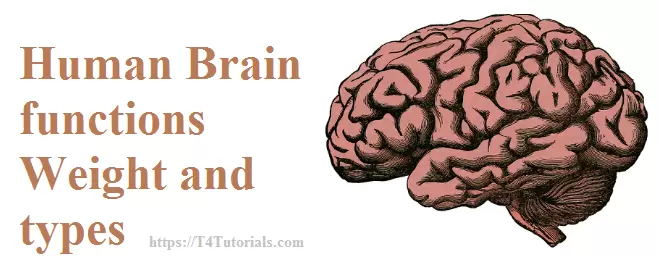Human Brain functions Weight Structure and types
Human Brain
Human Brain is the most complex part of the human body. All mental activities are controlled by the brain. It is the central control. It accepts signals from the body’s sensory organs and outputs information to the muscles.
What is the human brain weight?
The adult human brain weighs is approximately 3 pounds (equals to the 1,300-1,400 g).
Some important facts about the brain are as follow
- The human brain is the largest brain than all other creature to body size.
- The average male has a brain volume of 1,274 cubic centimeters.
- The average female brain has a volume of 1,131 cm3.
- The brain makes up about 2 percent of a human’s body weight.
- The human brain has the ability to produce almost 23 watts of power when aware.
- Human Brain gets 20 % of oxygen and blood that is produced in our body.
- 100 billion neurons exist in the human brain.

Structure of the Human Brain
The human brain has three parts
- Hindbrain
- Midbrain
- Forebrain
Details of all parts are as follow.
Hindbrain
The hindbrain is the fine covered central core of the brain. It has the ]cerebellum, reticular formation, and brain stem, which are important for some of the most basic self-moving actions of life, such as inhaling and movement. The brain stem includes the pons and medulla oblongata. , the hindbrain has the earliest parts of the brain, which all creature occupy, still, they may look different from breed to breed.
There are the following parts of the hindbrain.
- Medulla Oblongata
- Pons
- Cerebellum
-
Medulla Oblongata
The medulla oblongata place between the brain and spinal cord. It basically belongs to the brain instead of the spinal cord. It controls breathing, cardiovascular, and digestive functions.
-
Pons
The Pons provide a connection between midbrain and module oblongata, and also provide signals from the forebrain to the cerebellum. It controls centers inhalation and inhibitory functions. The cerebellum is linked to the back side of the pons.
-
Cerebellum
The cerebellum is a structure that also known as the little brain. The cerebellum is a separate part of the brain placed at the back of the medulla oblongata and pons.
The cerebellum accepts information from following organs like eyes and ears etc., It basically uses to control voluntary movements like eyes blinking and moving of objects. Ans also used to control and provide balance in behavior that is very fast like running.. it also provides mussels coordination. And it provides support in cerebellum play an important role in controlling emotional sensitivity
Brain stem
The part of the brain regular with the spinal cord and contain the medulla oblongata and Pons and midbrain and parts of the hypothalamus
Midbrain
The midbrain forms the part of the brain stem. It is placed between the hindbrain and forebrain. It is small in size than forebrain and hindbrain. It is responsible for transferring all neural and motor information between forebrain and spinal cord, this makes it the central nerves system. Midbrain plat an important role in visual processing.
Forebrain
The forebrain is the most important part of the brain, having the most complicated networks in the central nervous system. It is the large and complicated forebrain that distinguishes the human brain from other vertebrate brains. The low-level structure of forebrain is as follow.
- The Diencephalon (“interbrain”)
- Thalamus
- Hypothalamus
- Spinal Cord
-
The Diencephalon
The diencephalon is the. In adults, it usually appears at the upper end of the brain stem in adults. It is home to the limbic system. The diencephalon is made up of four different components: the thalamus, the subthalamus, the hypothalamus, and the epithalamus.
-
Thalamus
The thalamus is part of the limbic system. It presents at the top of the brain stem. It is placed between the cerebral cortex and the midbrain. It used to perform many important functions. For example, consciousness, sleep, and sensory interpretation .thalamus has two parts called its lobs. These lobes are symmetrical and are about the size of a walnut, it’s working same like a switchboard for the brain. Because the switch board is responsible for receiving information. The thalamus is critical in relaying sensory information to the brain.
-
Hypothalamus
The hypothalamus is a small part of the brain. It is present just under the thalamus. It is responsible to coordinate certain behavior that known as “maintenance” behaviors including eating, drinking, body temperature. The hypothalamus also helps the endocrine system (glands that produce hormones) using the pituitary gland. When exterior stimuli are granted (for example, unsafe or unstable stimuli), the hypothalamus transmits signals to other limbic areas to produce feeling attitude in reply to the stimuli like in the frightening situation.
-
Spinal Cord
The spinal cord is a long tubular batch of nerve tissue. These tissues connect with the brain through Central Nerves system and transmit information to and from the body. The size of the spinal cord in the adults is about 40 cm long and weighs almost 30 g. The brain and spinal cord together make up a Central Nervous System. The basic work of the spinal cord to transmit the nerve signal from the motor cortex to the body. It also enables flexible motion. The spinal cord is attached to the bottom of the medulla oblongata, and is organized to serve four different tasks:
- It transmits all sensory information to the brain;
- It is used to transmit information to a peripheral that generated in the brain.
- It is used to control all near organs through the autonomic nervous system;
- To enable sensor motor functions to control condition and other major movements.